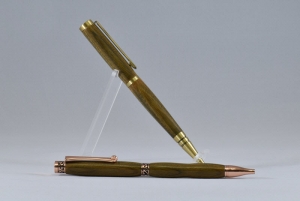We picked up a larger turning block from Rockler that was labeled as lignum Vitae. It has a nice green color that we liked. I finally got around to cutting it into pen blanks for my daughter today and the cut sides are yellowish brown. I read that with oxidation, it will turn green like the outer edges but I had a few questions.
When Rebecca turns it for pens, should she apply the finish to keep it yellow if that's what she wants? If she wants the greenish color, how long does the wood have to be exposed to oxidize? Any tips to speed up that process?
Here is a photo of the 4 pieces I cut today showing the cut edge and the outside green edge.
Thanks!

Sent from my SAMSUNG-SM-G890A using Tapatalk
When Rebecca turns it for pens, should she apply the finish to keep it yellow if that's what she wants? If she wants the greenish color, how long does the wood have to be exposed to oxidize? Any tips to speed up that process?
Here is a photo of the 4 pieces I cut today showing the cut edge and the outside green edge.
Thanks!
Sent from my SAMSUNG-SM-G890A using Tapatalk

